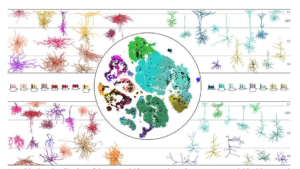NIH BRAIN Initiative unveils detailed Atlas of the Mammalian Primary Motor Cortex
The NIH Brain Research Through Advancing Innovative Neurotechnologies (BRAIN) Initiative Cell Census Network (BICCN) [1] has unveiled an atlas of cell types and an anatomical neuronal wiring diagramme for the mammalian primary motor cortex, derived from detailed studies of mice, monkeys, and humans. This publicly available resource represents the culmination of an international collaborative effort by more than 250 scientists at more than 45 institutions across 3 continents. The atlas provides a foundation for more in-depth study of cell types in the rest of the mammalian brain and may help scientists translate research done in animal models to humans. The findings appear as 17 associated papers published in a dedicated issue of the journal Nature.
“Thanks to this groundbreaking collaboration, we now have a comprehensive understanding of the brain cells found in the motor cortex of the brain and their basic functional properties,” said NIH Director Francis S. Collins, M.D., Ph.D. “The atlas will provide a springboard for future research into the structure and function of the brain within and across species.”
Joshua Gordon, M.D., Ph.D., director of the National Institute of Mental Health, commented: “Through an impressive integration of data from multiple cutting-edge techniques, the BICCN has created a comprehensive reference that catalogues and characterizes the many types of cells found in the mammalian primary motor cortex, describing their proportions, spatial distributions, anatomical and physio-logical characteristics, and molecular genetic profiles. This work represents a crucial step that will dramatically enhance the pace of advances in understanding the brain.”
The human brain is an incredibly complex organ, consisting of about one hundred billion neurons and roughly an equivalent number of non-neuronal cells and trillions of neuronal connections. Although all humans share the same general brain structure, a variety of environmental and genetic factors shape how our brains develop and function. In other words, each person’s brain reflects their unique background and life experiences. A full accounting of all the cell types that comprise the brain, their characteristics, and how they differ from individual to individual is crucial for understanding what makes us human.
Importantly, understanding the factors that play a role in the development of the structure and function of the brain is an essential step to learning how diseases – such as schizophrenia, addiction, seizure disorders, and Alzheimer’s disease – develop.
“There is an urgent need to develop therapies for brain-based disorders. Research conducted as part of BICCN will provide scientists with tools that enable precise targeting of cell types and neural networks by genomic therapy for disorders that affect thinking, memory, mood, and movement,” said Walter Koroshetz, M.D., director of the U.S. National Institute of Neurological Disorders and Stroke.
Transcriptome and epigenome
Scientific advances in the past 10 years have allowed researchers to move beyond analysing just the physical characteristics of brain cells to investigating molecular features underlying cell function. Researchers can now examine the transcriptome (the complete set of gene readouts in a cell, which contains instructions for making proteins and other cellular products) and the epigenome of a cell (the set of chemical modifications to the DNA of the cell, which alters the way the cell’s genetic information is expressed). Technical innovations have now scaled to allow for the rapid, cost-effective analysis of tens of millions of individual cells in the effort to better understand the building blocks of the brain.
These scientific advances provide researchers with the opportunity to understand the structure and function of the brain at an unprecedented level of detail. In 2017, the BICCN brought together teams of researchers in a coordinated effort to develop a comprehensive reference of cell types in the human brain, the monkey brain, and the mouse brain. The BICCN researchers set out to catalogue and map the different cells of the mammalian brain much like a population census, in which census takers record individuals’ demographic and geographic characteristics. The researchers focused on the primary motor cortex, an area of the brain involved in controlling complex movement that is known to be similar across mammalian species.
In the current series of studies, researchers used a battery of singlecell transcriptome and epigenome measurements obtained from millions of cells in the motor cortex to create a cross-species, datadriven framework of brain cell types. The researchers characterized the brain cell types they found by using a combination of electrophysiological, morphological, and circuit tracing approaches. They also used data from single-cell transcriptome and epigenome analysis to identify unique gene markers that define the many different cell types found in the primary motor cortex.
More than a compendium of cell types
It is important to note that this work is more than a compendium of cell types, as it also identifies genetic tools that allow researchers to precisely monitor and modulate the neural activity of specific cell types.
The researchers identified similar cell types across mice, monkeys, and humans but also important differences in gene expression that may be responsible for variations in the way these three species process neural information.
These initial results set the foundation for future research efforts that dive deeper into the structure and function of cells in the mammalian brain. These studies may include efforts to understand how the brain matures and develops, as well as research examining the roles that distinct cell types play in the creation of complex thought and behaviour.
“This important work couldn’t have happened without the many minds, institutions, and organizations who came together to solve a very complex problem,” said Andrea Beckel-Mitchener, Ph.D., deputy director of the NIH BRAIN Initiative. “These studies are an example of how collaboration can foster science and set the wheels in motion for future efforts that will revolutionize our ability to study brain function and brain disorders.”
References
1. BRAIN Initiative. https://braininitiative.nih.gov/brain-programs/cell-census-network-biccn


